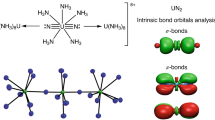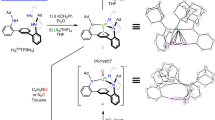Abstract
Uranium occurs in the environment predominantly as the uranyl dication [UO2]2+. Its solubility renders this species a problematic contaminant1,2,3 which is, moreover, chemically extraordinarily robust owing to strongly covalent U–O bonds4. This feature manifests itself in the uranyl dication showing little propensity to partake in the many oxo group functionalizations and redox reactions typically seen with [CrO2]2+, [MoO2]2+ and other transition metal analogues5,6,7,8,9. As a result, only a few examples of [UO2]2+ with functionalized oxo groups are known. Similarly, it is only very recently that the isolation and characterization of the singly reduced, pentavalent uranyl cation [UO2]+ has been reported10,11,12. Here we show that placing the uranyl dication within a rigid and well-defined molecular framework while keeping the environment anaerobic allows simultaneous single-electron reduction and selective covalent bond formation at one of the two uranyl oxo groups. The product of this reaction is a pentavalent and monofunctionalized [O = U ... OR]+ cation that can be isolated in the presence of transition metal cations. This finding demonstrates that under appropriate reaction conditions, the uranyl oxo group will readily undergo radical reactions commonly associated only with transition metal oxo groups. We expect that this work might also prove useful in probing the chemistry of the related but highly radioactive plutonyl and neptunyl analogues found in nuclear waste.
This is a preview of subscription content, access via your institution
Access options
Subscribe to this journal
Receive 51 print issues and online access
$199.00 per year
only $3.90 per issue
Buy this article
- Purchase on Springer Link
- Instant access to full article PDF
Prices may be subject to local taxes which are calculated during checkout


Similar content being viewed by others
References
Amme, M., Wiss, T., Thiele, H., Boulet, P. & Lang, H. Uranium secondary phase formation during anoxic hydrothermal leaching processes of UO2 nuclear fuel. J. Nucl. Mater. 341, 209–223 (2005)
Lovley, D. R., Phillips, E. J. P., Gorby, Y. A. & Landa, E. R. Microbial reduction of uranium. Nature 350, 413–416 (1991)
Suzuki, Y., Kelly, S. D., Kemner, K. M. & Banfield, J. F. Radionuclide contamination: Nanometre-size products of uranium bioreduction. Nature 419, 134 (2002)
Denning, R. G. Electronic structure and bonding in actinyl ions and their analogs. J. Phys. Chem. A 111, 4125–4143 (2007)
Kühn, F. E., Santos, A. M. & Abrantes, M. Mononuclear organomolybdenum(vi) dioxo complexes: Synthesis, reactivity, and catalytic applications. Chem. Rev. 106, 2455–2475 (2006)
Nam, W. High-valent iron(iv)-oxo complexes of heme and non-heme ligands in oxygenation reactions. Acc. Chem. Res. 40, 522–531 (2007)
Jin, N., Ibrahim, M., Spiro, T. G. & Groves, J. T. Trans-dioxo manganese(v) porphyrins. J. Am. Chem. Soc. 129, 12416–12417 (2007)
Limberg, C. The role of radicals in metal-assisted oxygenation reactions. Angew. Chem. Int. Edn Engl. 42, 5932–5954 (2003)
Mayer, J. M. Hydrogen atom abstraction by metal–oxo complexes: Understanding the analogy with organic radical reactions. Acc. Chem. Res. 31, 441–450 (1998)
Burdet, F., Pecaut, J. & Mazzanti, M. Isolation of a tetrameric cation-cation complex of pentavalent uranyl. J. Am. Chem. Soc. 128, 16512–16513 (2006)
Natrajan, L., Burdet, F., Pecaut, J. & Mazzanti, M. Synthesis and structure of a stable pentavalent-uranyl coordination polymer. J. Am. Chem. Soc. 128, 7152–7153 (2006)
Berthet, J. C., Siffredi, G., Thuery, P. & Ephritikhine, M. Easy access to stable pentavalent uranyl complexes. Chem. Commun.3184–3186 (2006)
Burns, C. J. et al. A trigonal bipyramidal uranyl amido complex: Synthesis and structural characterization of Na(thf)2UO2{N(SiMe3)2}3 . Inorg. Chem. 39, 5464–5468 (2000)
Sarsfield, M. J., Helliwell, M. & Raftery, J. Distorted equatorial coordination environments and weakening of U = O bonds in uranyl complexes containing NCN and NPN ligands. Inorg. Chem. 43, 3170–3179 (2004)
Sarsfield, M. J. & Helliwell, M. Extending the chemistry of the uranyl ion: Lewis acid coordination to a U = O oxygen. J. Am. Chem. Soc. 126, 1036–1037 (2004)
Kannan, S., Vaughn, A. E., Weis, E. M., Barnes, C. L. & Duval, P. B. Anhydrous photochemical uranyl(vi) reduction: Unprecedented retention of equatorial coordination accompanying reversible axial oxo/alkoxide exchange. J. Am. Chem. Soc. 128, 14024–14025 (2006)
Arnold, P. L., Blake, A. J., Wilson, C. & Love, J. B. Uranyl complexation by a Schiff-base, polypyrrolic macrocycle. Inorg. Chem. 43, 8206–8208 (2004)
Arnold, P. L., Patel, D., Blake, A. J., Wilson, C. & Love, J. B. Selective oxo functionalization of the uranyl ion with 3d metal cations. J. Am. Chem. Soc. 128, 9610–9611 (2006)
Docrat, T. I. et al. X-ray absorption spectroscopy of tricarbonatodioxouranate(v), [UO2(CO3)3]5–, in aqueous solution. Inorg. Chem. 38, 1879–1882 (1999)
Hay, P. J., Martin, R. L. & Schreckenbach, G. Theoretical studies of the properties and solution chemistry of AnO2 2+ and AnO2+ aquo complexes for An = U, Np, and Pu. J. Phys. Chem. A 104, 6259–6270 (2000)
Wander, M. C. F., Kerisit, S., Rosso, K. M. & Schoonen, M. A. A. Kinetics of triscarbonato uranyl reduction by aqueous ferrous iron: A theoretical study. J. Phys. Chem. A 110, 9691–9701 (2006)
Zi, G. et al. Preparation and reactions of base-free bis(1,2,4-tri-tert-butylcyclopentadienyl)uranium oxide, Cp'2UO. Organometallics 24, 4251–4264 (2005)
Cotton, F. A., Marler, D. O. & Schwotzer, W. Dinuclear uranium alkoxides: preparation and structures of KU2(OCMe3)9, U2(OCMe3)9, and U2(OCHMe2)10, containing [U(iv),U(iv)], [U(iv),U(v)], and [U(v),U(v)], respectively. Inorg. Chem. 23, 4211–4215 (1984)
Donahue, J. P., Goldsmith, C. R., Nadiminti, U. & Holm, R. H. Synthesis, structures, and reactivity of bis(dithiolene)molybdenum(iv,vi) complexes related to the active sites of molybdoenzymes. J. Am. Chem. Soc. 120, 12869–12881 (1998)
Lorber, C., Donahue, J. P., Goddard, C. A., Nordlander, E. & Holm, R. H. Synthesis, structures, and oxo transfer reactivity of bis(dithiolene)tungsten(iv, vi) complexes related to the active sites of tungstoenzymes. J. Am. Chem. Soc. 120, 8102–8112 (1998)
O'Grady, E. & Kaltsoyannis, N. On the inverse trans influence. Density functional studies of [MOX5] n– (M = Pa, n = 2; M = U, n = 1; M = Np, n = 0; X = F, Cl or Br). J. Chem. Soc., Dalton Trans.1233–1239 (2002)
Costes, J. P., Dahan, F., Dupuis, A. & Laurent, J. P. Nature of the magnetic interaction in the (Cu2+, Ln3+) pairs: An empirical approach based on the comparison between homologous (Cu2+, Ln3+) and (NiLS 2+, Ln3+) complexes. Chem. Eur. J. 4, 1616–1620 (1998)
Castro-Rodriguez, I., Olsen, K., Gantzel, P. & Meyer, K. Uranium tris-aryloxide derivatives supported by triazacyclononane: engendering U(iii) center with a single pocket for reactivity. J. Am. Chem. Soc. 125, 4565–4571 (2003)
Rosen, R. K., Andersen, R. A. & Edelstein, N. M. A bimetallic molecule with antiferromagnetic coupling between the uranium centres. J. Am. Chem. Soc. 112, 4588–4590 (1990)
Reilly, S. D. & Neu, M. P. Pu(vi) hydrolysis: further evidence for a dimeric plutonyl hydroxide and contrasts with U(vi) chemistry. Inorg. Chem. 45, 1839–1846 (2006)
Acknowledgements
We thank the EPSRC (UK), the Royal Society, and the Universities of Edinburgh and Nottingham for support, J. Sanchez-Benitez and P. Anderson of Edinburgh University for help with magnetic susceptibility measurements and chloride analysis respectively, R. Edge and the EPSRC EPR service at the University of Manchester, and D. Leigh for his advice.
Author Contributions D.P. synthesized and characterized the compounds, and solved the crystal structure data. C.W. mounted the crystals, collected the single-crystal X-ray crystallographic data, modelled the disorder components in the structures, and checked the final structure solutions. P.L.A. and J.B.L. generated and managed the project, helped characterize the complexes, analysed the data and wrote the manuscript.
Author information
Authors and Affiliations
Corresponding authors
Supplementary information
Supplementary Information
This file contains Supplementary Methods, Supplementary Table S1, Supplementary Figures S1-S3 with Legends and additional references. The document describes general experimental procedures, synthetic and characterisation data for compounds 1 to 6, and additional reactivity studies. The Supplementary Figures show FTIR spectroscopic data (1), selected variable temperature magnetic susceptibility data (3), and preliminary EPR data (1) for complexes 1 to 6. Crystallographic details for 3 and 5. (PDF 865 kb)
Rights and permissions
About this article
Cite this article
Arnold, P., Patel, D., Wilson, C. et al. Reduction and selective oxo group silylation of the uranyl dication. Nature 451, 315–317 (2008). https://doi.org/10.1038/nature06467
Received:
Accepted:
Issue Date:
DOI: https://doi.org/10.1038/nature06467
This article is cited by
-
Uranyl adsorption: recent progress of covalent organic framework materials
Journal of Radioanalytical and Nuclear Chemistry (2023)
-
Rare radioisotopes at the ready
Nature Chemistry (2022)
-
Ion association with tetra-n-alkylammonium cations stabilizes higher-oxidation-state neptunium dioxocations
Nature Communications (2019)
-
Gas-Phase Deconstruction of UO22+: Mass Spectrometry Evidence for Generation of [OUVICH]+ by Collision-Induced Dissociation of [UVIO2(C≡CH)]+
Journal of the American Society for Mass Spectrometry (2019)
-
Elucidating bonding preferences in tetrakis(imido)uranate(VI) dianions
Nature Chemistry (2017)
Comments
By submitting a comment you agree to abide by our Terms and Community Guidelines. If you find something abusive or that does not comply with our terms or guidelines please flag it as inappropriate.



